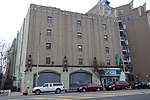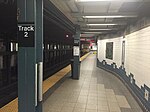Midwood High School
1940 establishments in New York CityAC with 0 elementsEducational institutions established in 1940Midwood, BrooklynPublic high schools in Brooklyn
Midwood High School is a high school located at 2839 Bedford Avenue in Brooklyn, New York City, administered by the New York City Department of Education. It has an enrollment of 3,938 students. Its H-shaped building, with six Ionic columns and a Georgian cupola, was constructed in 1940 as part of the Works Projects Administration.
Excerpt from the Wikipedia article Midwood High School (License: CC BY-SA 3.0, Authors).Midwood High School
East 26th Street, New York Brooklyn
Geographical coordinates (GPS) Address Nearby Places Show on map
Geographical coordinates (GPS)
| Latitude | Longitude |
|---|---|
| N 40.632833333333 ° | E -73.951916666667 ° |
Address
East 26th Street 725
11210 New York, Brooklyn
New York, United States
Open on Google Maps







